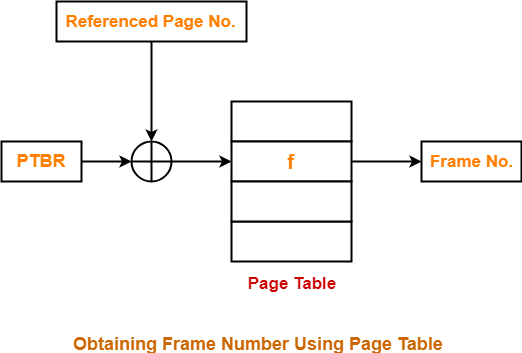Paging in OS-
Before you go through this article, make sure that you have gone through the previous article on Paging in OS.
We have discussed-
- Paging is a non-contiguous memory allocation technique.
- The logical address generated by the CPU is translated into the physical address using the page table.
In this article, we will discuss about Page Table.
Page Table-
- Page table is a data structure.
- It maps the page number referenced by the CPU to the frame number where that page is stored.
Characteristics-
- Page table is stored in the main memory.
- Number of entries in a page table = Number of pages in which the process is divided.
- Page Table Base Register (PTBR) contains the base address of page table.
- Each process has its own independent page table.
Working-

- Page Table Base Register (PTBR) provides the base address of the page table.
- The base address of the page table is added with the page number referenced by the CPU.
- It gives the entry of the page table containing the frame number where the referenced page is stored.
Page Table Entry-
- A page table entry contains several information about the page.
- The information contained in the page table entry varies from operating system to operating system.
- The most important information in a page table entry is frame number.
In general, each entry of a page table contains the following information-

1. Frame Number-
- Frame number specifies the frame where the page is stored in the main memory.
- The number of bits in frame number depends on the number of frames in the main memory.
2. Present / Absent Bit-
- This bit is also sometimes called as valid / invalid bit.
- This bit specifies whether that page is present in the main memory or not.
- If the page is not present in the main memory, then this bit is set to 0 otherwise set to 1.
NOTE
|
3. Protection Bit-
- This bit is also sometimes called as “Read / Write bit“.
- This bit is concerned with the page protection.
- It specifies the permission to perform read and write operation on the page.
- If only read operation is allowed to be performed and no writing is allowed, then this bit is set to 0.
- If both read and write operation are allowed to be performed, then this bit is set to 1.
4. Reference Bit-
- Reference bit specifies whether that page has been referenced in the last clock cycle or not.
- If the page has been referenced recently, then this bit is set to 1 otherwise set to 0.
NOTE
|
5. Caching Enabled / Disabled-
- This bit enables or disables the caching of page.
- Whenever freshness in the data is required, then caching is disabled using this bit.
- If caching of the page is disabled, then this bit is set to 1 otherwise set to 0.
6. Dirty Bit-
- This bit is also sometimes called as “Modified bit“.
- This bit specifies whether that page has been modified or not.
- If the page has been modified, then this bit is set to 1 otherwise set to 0.
NOTEIn case the page is modified,
|
To gain better understanding about Page Table Entry,
Next Article- Paging Important Formulas
Get more notes and other study material of Operating System.
Watch video lectures by visiting our YouTube channel LearnVidFun.
Summary

Article Name
Page Table | Paging in Operating System
Description
Paging in OS uses a data structure called as page table. Page Table stores the frame number where pages of the process are stored. Page Table Entry contains several information about the page. Page Table Entry Format.
Author
Akshay Singhal
Publisher Name
Gate Vidyalay
Publisher Logo
